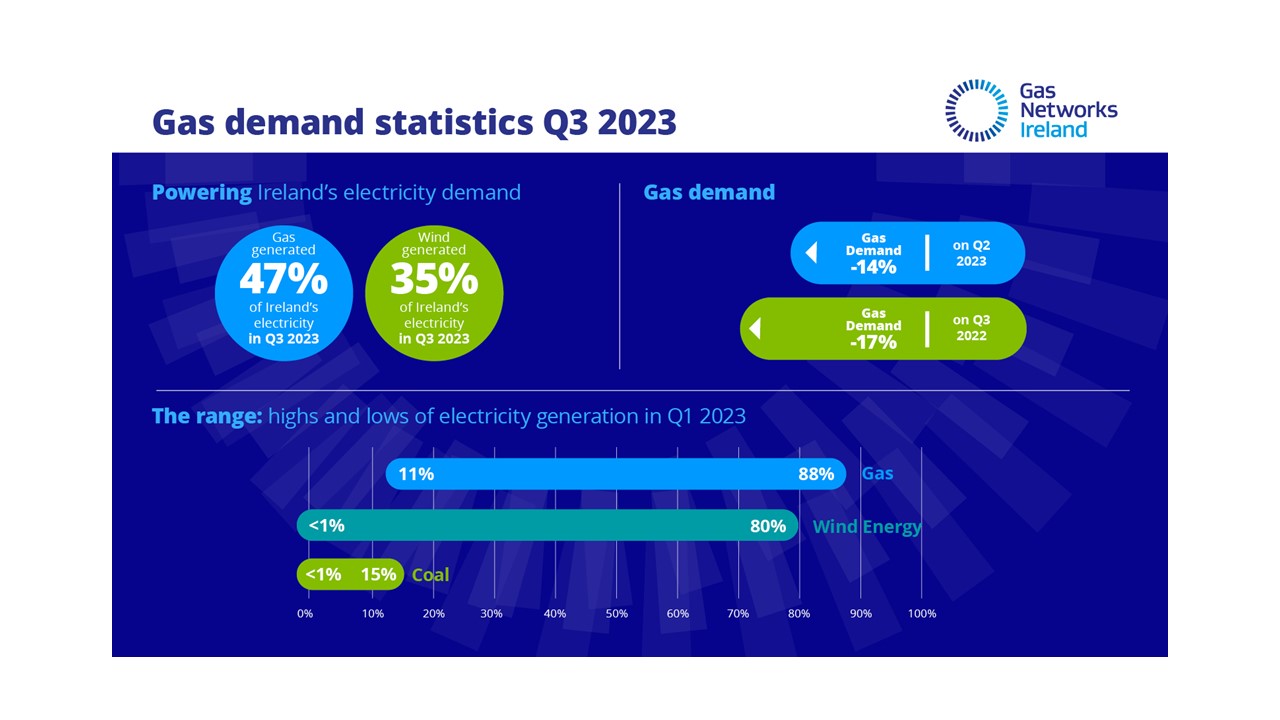September 2023 gas demand
Gas demand fell by 13% in September compared to the same month last year.
This September was a very mild, sunny and wet month that brought everything from heatwaves to the first named storm of the season.
Gas generated 46% of Ireland's electricity in September, as it did during August. The contribution of gas declined significantly compared to last September when it generated 55% of electricity in the state.
Wind energy generated 35% of Ireland's electricity in September, as it had done in August. Its overall contribution was up by 10 percentage points year-on-year, as wind generated 25% in September 2022.
Wind energy's contribution to the country's electricity generation peaked at one point in the month at 80%. However, given the variable nature of weather dependent renewable energy sources, there were also times during the month when the wind supply dropped almost completely and contributed less than 1%.
Coal contributed a total of 5% to Ireland's electricity generation in September, peaking at 15%.
Demand for gas dropped year-on-year in the education1 (-40%), hotel (-19%) and office2 (-16%) sectors.
There were month-on-month increases in gas demand from the education1 (+64%), air travel3 (+45%), construction (+34%) and office (+20%) sectors.
For the ninth month in a row, demand for gas in transport saw a year-on-year increase, increasing by 40% year-on-year in September. Fuelling with compressed natural gas (CNG) can reduce a heavy good vehicle's (HGV) emissions by up to 22%, and with CNG suppliers now sourcing gas via renewable sources, BioCNG can turn an HGV into a carbon neutral vehicle, providing the Irish haulage industry with a clean alternative fuel option.
For a few hours during Storm Agnes, which hit much of the country on September 27th, wind energy's contribution to Ireland's electricity generation surpassed the country's electricity demand for the very first time. Wind did not exceed the overall amount of power generated at the time, as total power supply to the electricity grid was higher than demand due to a number of factors, and excess power was also exported to the UK via the electricity interconnector.
However, the stormy end to the month was in stark contrast to its sunny start. For only fourth time on record, Ireland experienced a heatwave in September4, and with less wind available at this time, gas produced 64% of Ireland's electricity, while wind energy accounted for just 15%.
Gas Networks Ireland's Acting Director of Strategy and Regulation, Brian Mullins, said:
"The month of September showcased how a complete energy system approach works in practice with wind and gas complementing each other to meet, when combined, 81% of Ireland's electricity demand.
With less wind around during the heatwave at the start of the month, gas stepped up and generated two thirds of the electricity needed in the country. In contrast, during the stormy and windy end to the month, wind energy broke another remarkable record in electricity generation. However, at the same time, gas's contribution peaked at 88% and never fell below 11% at any point in September.
Demonstrating the flexibility and reliability of gas and the gas network which continues to provide a secure and complete energy system and a reminder that even as wind energy breaks records, Ireland still needs gas to keep the country's lights on. We are working to increasingly replace natural gas with renewable gases on the renewables-ready 14,664km national gas network to reduce carbon emissions."
Q3 2023 gas demand
In the third quarter of 2023 - from July until the end of September - gas demand dropped by 14% on the previous quarter, and by 17% when compared to Q3 2022.
Wind energy generated 35% of the electricity needed by the State in Q3, an increase on its 27% contribution in the preceding three-month period, and a significant increase on the 22% it generated in the same period last year.
During Q3 2023, gas peaked at 88% and never dropped below 11%, while wind energy generated up to 80%, but at times fell away to less than 1%. Coal contributed 4% to electricity generation in the third quarter, peaking at 15%.
